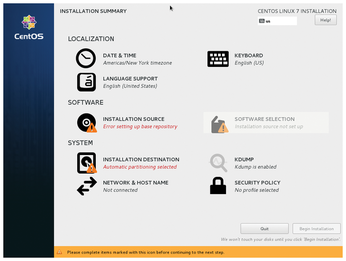Bringing Up Clouds
Core Technology

VM instances in the cloud are different beasts, even if they start off as a single image. Discover how they get their configuration in this month's Core Technologies.
First as a buzzword and then as a commodity, the cloud lives the typical life of an IT industry phenomenon. This means that running something (but usually Linux) in a cloud is a thing you now do more often than not. From a user perspective, it's simple: You click a button on the cloud provider's dashboard and get your virtual machine (VM) running within a minute.
This is drastically different from what you do on your desktop. Here, you insert the DVD or plug in a USB pen drive and spawn the installer. Be it an old-school, text-based or a slick GUI installer, it typically asks you some questions (Figure 1). Which locale do you want to use? What's your computer's hostname? What's your time zone? How do you want your user account named? Which password do you want to use? You may not even notice these questions, because installation takes a quarter of an hour or more, and you spend most of this time sipping coffee or chatting with friends. Yet these questions are essential for the system's operation. Without a password, you won't be able to log in. Or, even worse, everyone will be able to.
[...]
Buy this article as PDF
(incl. VAT)
Buy Linux Magazine
Subscribe to our Linux Newsletters
Find Linux and Open Source Jobs
Subscribe to our ADMIN Newsletters
Support Our Work
Linux Magazine content is made possible with support from readers like you. Please consider contributing when you’ve found an article to be beneficial.

News
-
Debian Unleashes Debian Libre Live
Debian Libre Live keeps your machine free of proprietary software.
-
Valve Announces Pending Release of Steam Machine
Shout it to the heavens: Steam Machine, powered by Linux, is set to arrive in 2026.
-
Happy Birthday, ADMIN Magazine!
ADMIN is celebrating its 15th anniversary with issue #90.
-
Another Linux Malware Discovered
Russian hackers use Hyper-V to hide malware within Linux virtual machines.
-
TUXEDO Computers Announces a New InfinityBook
TUXEDO Computers is at it again with a new InfinityBook that will meet your professional and gaming needs.
-
SUSE Dives into the Agentic AI Pool
SUSE becomes the first open source company to adopt agentic AI with SUSE Enterprise Linux 16.
-
Linux Now Runs Most Windows Games
The latest data shows that nearly 90 percent of Windows games can be played on Linux.
-
Fedora 43 Has Finally Landed
The Fedora Linux developers have announced their latest release, Fedora 43.
-
KDE Unleashes Plasma 6.5
The Plasma 6.5 desktop environment is now available with new features, improvements, and the usual bug fixes.
-
Xubuntu Site Possibly Hacked
It appears that the Xubuntu site was hacked and briefly served up a malicious ZIP file from its download page.


